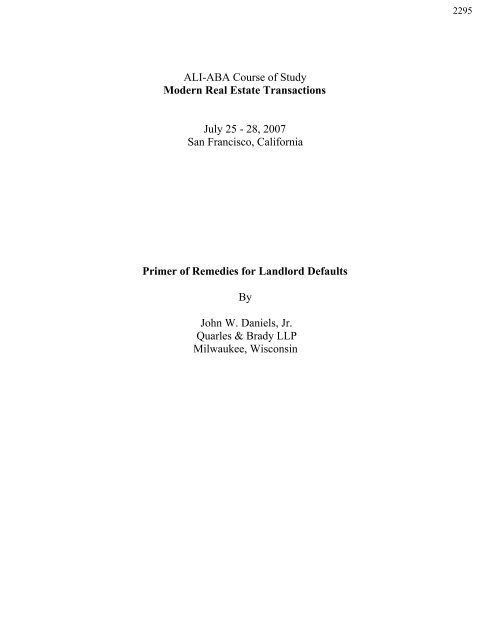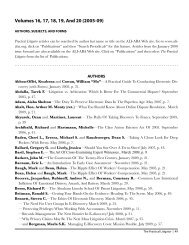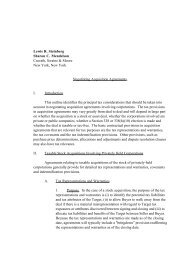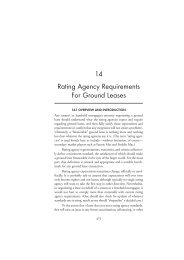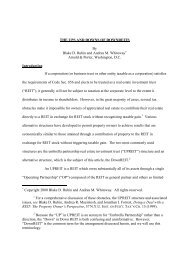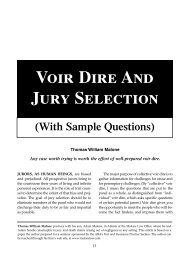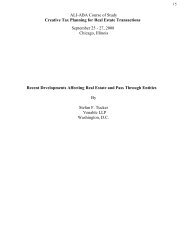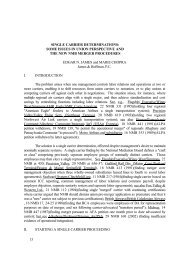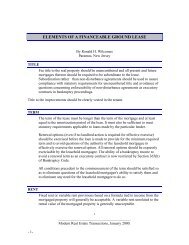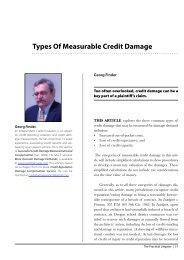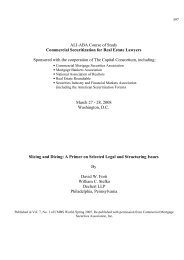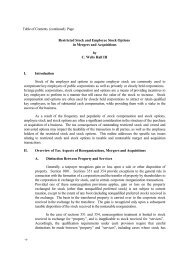ALI-ABA Course of Study Modern Real Estate Transactions July 25 ...
ALI-ABA Course of Study Modern Real Estate Transactions July 25 ...
ALI-ABA Course of Study Modern Real Estate Transactions July 25 ...
You also want an ePaper? Increase the reach of your titles
YUMPU automatically turns print PDFs into web optimized ePapers that Google loves.
2295<br />
<strong>ALI</strong>-<strong>ABA</strong> <strong>Course</strong> <strong>of</strong> <strong>Study</strong><br />
<strong>Modern</strong> <strong>Real</strong> <strong>Estate</strong> <strong>Transactions</strong><br />
<strong>July</strong> <strong>25</strong> - 28, 2007<br />
San Francisco, California<br />
Primer <strong>of</strong> Remedies for Landlord Defaults<br />
By<br />
John W. Daniels, Jr.<br />
Quarles & Brady LLP<br />
Milwaukee, Wisconsin
2296<br />
2
2297<br />
PRIMER OF REMEDIES FOR LANDLORD DEFAULTS<br />
John W. Daniels, Jr. 1<br />
Quarles & Brady LLP<br />
Milwaukee, Wisconsin<br />
I. COMMON LAW REMEDIES AVAILABLE TO TENANT WHEN LANDLORD DEFAULTS.<br />
A. Equitable Remedies.<br />
1. Rescission <strong>of</strong> lease prior to commencement <strong>of</strong> lease term. See<br />
RESTATEMENT (SECOND) OF PROPERTY §§ 4.2 and 6.2 (1976 & Supp.<br />
2003); S&D Group, Inc. v. Talamas, 710 S.W.2d 680 (Tex. Civ. App.<br />
1986) (sublessee could rescind where sublessor failed to deliver<br />
possession); Draper Mach. Works, Inc. v. Hagberg, 34 Wash. App. 483,<br />
663 P.2d 141 (1983) (Tenant waived rescission for failure to deliver<br />
possession by occupying portion <strong>of</strong> premises); Crown Plaza Corp. v.<br />
Synapse S<strong>of</strong>tware Sys., Inc., 87 Wash. App. 495, 962 P.2d 824 (Wash.<br />
1997); see also Blanc’s Cafe v. Corey, 110 Wash. 242, 188 P. 759 (1920)<br />
(Tenant could maintain action for ejectment against Landlord who failed<br />
to timely deliver possession).<br />
2. Termination <strong>of</strong> lease after commencement <strong>of</strong> lease term.<br />
a. Constructive eviction (see Article III below for a discussion <strong>of</strong><br />
constructive eviction).<br />
b. Failure to cure misrepresentation <strong>of</strong> environmental condition. See<br />
Zwerdling v. Zack, 202 A.D.2d 577, 609 N.Y.S.2d <strong>25</strong>9 (1994);<br />
Heritage on Lanier, Inc. v. Akins, 216 Ga. App. 280, 454 S.E.2d<br />
172 (1995). In Akins, the Tenant counterclaimed for rescission <strong>of</strong><br />
the lease based on the Landlord’s misrepresentation <strong>of</strong> the<br />
environmental condition <strong>of</strong> the premises. The court remanded the<br />
question to the trial court for further fact finding.<br />
c. Failure to provide environmental audit and contamination <strong>of</strong> the<br />
premises. See Fla. Atlantic Marine, Inc. v. Seminole Boatyard,<br />
Inc., 630 So.2d 219 (Fla. Dist. Ct. App. 1994). In Seminole<br />
Boatyard, the Tenant sought rescission <strong>of</strong> the lease and damages<br />
for the Landlord’s (i) failure to provide the Tenant with an<br />
environmental audit as required under the lease and (ii) the<br />
Landlord’s contamination <strong>of</strong> the premises. The court remanded the<br />
question to the trial court for further fact finding.<br />
1 This outline was prepared with the assistance <strong>of</strong> Shawn D. Gould (Boalt Hall 2001), an associate in the <strong>Real</strong> <strong>Estate</strong><br />
Practice Group <strong>of</strong> the firm.<br />
QBMKE\5422644.4
2298<br />
3. Specific performance.<br />
a. Landlord’s breach <strong>of</strong> contract to lease. See Ryan v. Stanger Inv.<br />
Co., 620 S.W.2d 505 (Tenn. Ct. App. 1981) (contract to lease is<br />
specifically enforceable); Wetherbee, Ltd. v. Allred, 969 S.W.2d<br />
756 (Mo. Ct. App. 1998).<br />
b. Landlord’s breach <strong>of</strong> a covenant to repair. See F.G. Madera,<br />
Annotation, Rights and Remedies <strong>of</strong> Tenant Upon Landlord’s<br />
Breach <strong>of</strong> Covenant to Repair, 28 A.L.R. 2d 446, 473 (1953 &<br />
Supp. 2003); Lucas v. Evans, 453 So. 2d 141 (Fla. Dist. Ct. App.<br />
1984) (Tenant was entitled to specific performance <strong>of</strong> Landlord’s<br />
repair covenant); but see also Boroch<strong>of</strong>f Props., Inc. v. Creative<br />
Printing Enters., Inc., 233 Ga. 279, 210 S.E.2d 809 (1974) (right to<br />
make repairs and recover costs and right to recover damages were<br />
adequate remedies at law); Continental & Vogue Health Studios,<br />
Inc. v. Abra Corporation, 369 Mich. 561, 120 N.W.2d 835 (1963)<br />
(no specific performance where remedy at law is adequate).<br />
c. Landlord’s breach <strong>of</strong> a restrictive covenant. See N.H. Donuts, Inc.<br />
v. Skiptaris, 129 N.H. 774, 533 A.2d 351 (1987) (Landlord ordered<br />
to remove a building that blocked premises from view <strong>of</strong> highway,<br />
in violation <strong>of</strong> covenant).<br />
4. Injunctive relief.<br />
a. Continuous or repeated acts creating a nuisance. See 49 AM. JUR.<br />
2d Landlord and Tenant § 544 (1995 & Supp. 2002) (injunction<br />
available under some circumstances).<br />
b. Other types <strong>of</strong> breaches <strong>of</strong> the covenant <strong>of</strong> quiet enjoyment. See<br />
Med Mac <strong>Real</strong>ty Co., Inc. v. Lemer, 154 A.D.2d 656, 547 N.Y.S.2d<br />
65 (1989) (Landlord was enjoined from interfering with Tenant’s<br />
alterations and sublease, which were permitted under lease); Am.<br />
Warehousing Servs., Inc. v. Weitzman, 169 Ill. App. 3d 708, 523<br />
N.E.2d 1082 (1988) (temporary restraining order was proper to<br />
prevent Landlord from using self-help remedy to block Tenant’s<br />
customers’ access to premises during rent dispute); S.E. Nichols,<br />
Inc. v. Am. Shopping Ctrs., Inc., 115 A.D.2d 856, 495 N.Y.S.2d<br />
810 (1985) (injunctive relief is available to prevent enforcement <strong>of</strong><br />
Landlord’s remedies until rights <strong>of</strong> parties can be settled, but only<br />
if requested before expiration <strong>of</strong> cure period for Tenant’s alleged<br />
default); Long Island Gynecological Serv. v. 1103 Stewart Ave.<br />
Assocs. Ltd. P’ship, 224 A.D.2d 591, 638 N.Y.S.2d 959 (1996)<br />
(Tenant able to obtain Yellowstone injunction even though sought<br />
after end <strong>of</strong> cure period because Tenant demonstrated that if could<br />
not cure the default within the prescribed thirty-day period);<br />
QBMKE\5422644.4<br />
- 2 -
2299<br />
Madigan Bros., Inc. v. Melrose Shopping Ctr. Co., 123 Ill. App. 3d<br />
851, 463 N.E.2d 824 (1984) (Tenant could enjoin Landlord from<br />
constructing restaurant in shopping center parking area where<br />
restaurant would interfere with Tenant’s nonexclusive parking<br />
easement); Pacemaker Food Stores, Inc. v. Seventh Mont Corp.,<br />
117 Ill. App. 3d 636, 453 N.E.2d 806 (1983) (Tenant could enjoin<br />
Landlord from granting access easement across common parking<br />
area to fast food restaurant); Mut. <strong>of</strong> Omaha Life Ins. Co. v.<br />
Executive Plaza, Inc., 99 Ill. App. 3d 190, 4<strong>25</strong> N.E.2d 503 (1981)<br />
(<strong>of</strong>fice Tenant could enjoin Landlord from turning a portion <strong>of</strong> a<br />
common parking area into restricted parking for another tenant);<br />
Checker Oil Co. v. Harold H. Hogg, Inc., <strong>25</strong>1 Pa. Super. 351, 380<br />
A.2d 815 (1977) (Tenant should have been granted a permanent<br />
injunction against Landlord’s obstruction <strong>of</strong> access to premises<br />
from major road adjacent to premises); Elfman v. Berman, 56 Pa.<br />
D. & C.4th 171 (2001) (Tenant entitled to a preliminary injunction<br />
instructing Landlord to repair building that Landlord had<br />
intentionally failed to maintain).<br />
5. Declaratory judgment. See Sun Ins. Services, Inc. v. 260 Peachtree<br />
Street, Inc., 192 Ga. App. 482, 385 S.E.2d 127 (1989) (Tenant obtained<br />
declaratory judgment that asbestos removal was Landlord’s obligation<br />
before Tenant began renovation work allowed by lease); Times Square<br />
Stores Corp., Inc. v. Bernice <strong>Real</strong>ty Co., Inc., 141 A.D.2d 536, 529<br />
N.Y.S.2d 148 (1988) (Landlord’s refusal to cooperate with Tenant’s<br />
expansion <strong>of</strong> building was unreasonable, so Court ordered Landlord to<br />
sign application for new certificate <strong>of</strong> occupancy); Middle Village Assocs.<br />
v. Pergament Home Centers, Inc., 184 Misc. 2d 552, 708 N.Y.S.2d 840<br />
(2000).<br />
B. Legal Remedies.<br />
1. Action for damages.<br />
a. Liquidated damages for Landlord’s failure to deliver possession.<br />
See 49 AM. JUR. 2d Landlord and Tenant § 501 (1995 & Supp.<br />
2002); Moses v. Autuono, 56 Fla. 499, 47 SO. 9<strong>25</strong> (1908);<br />
Omohundro v. Ottenheimer, 198 Ark. 137, 127 S.W.2d 642<br />
(1939); Boltz v. Crawford & North Aves. Theatre Co., 294 Ill. App.<br />
<strong>25</strong>8, 13 N.E.2d 844 (1938).<br />
b. Damages for breach <strong>of</strong> other obligations <strong>of</strong> Landlord.<br />
i. Measure <strong>of</strong> damages. See RESTATEMENT (SECOND) OF<br />
PROPERTY § 10.2 (1976 & Supp. 2003); Eugene L. Grant,<br />
Disturbing Concepts: Quiet Enjoyment and Constructive<br />
Eviction in the <strong>Modern</strong> Commercial Lease, 35 REAL PROP.<br />
QBMKE\5422644.4<br />
- 3 -
2300<br />
PROB. & TR. J. 57 (Spring, 2000); Eugene L. Grant,<br />
Avoiding the Risks: Subrogation, Indemnification, and<br />
Exculpation in the Context <strong>of</strong> Commercial Leases, 21 REL.<br />
EST. L. J. <strong>25</strong>5 (Winter, 1993); Richard M. Frome et al.,<br />
Tenant Remedies: An Oxymoron, 12 PROB. & PROP. 39<br />
(Jan./Feb., 1998). Tenant may be able to obtain the<br />
following damages:<br />
A. Difference between rental value <strong>of</strong> premises in<br />
condition required by lease and rental value <strong>of</strong><br />
premises in defective condition. See Madison<br />
Assocs. v. Bass, 158 Ill. App. 3d 526, 511 N.E.2d<br />
690 (1987) (no damages awarded where Tenant<br />
failed to present evidence <strong>of</strong> rental value <strong>of</strong><br />
defective premises); Sigsbee v. Swathwood, 419<br />
N.E.2d 789 (Ind. Ct. App. 1981); Quebe v. Davis,<br />
586 N.E.2d 914 (Ind. Ct. App. 1992).<br />
B. Actual expenses incurred by Tenant in curing<br />
Landlord’s default. See F.G. Madera, Annotation,<br />
Rights and Remedies <strong>of</strong> Tenant Upon Landlord’s<br />
Breach <strong>of</strong> Covenant to Repair, 28 A.L.R. 2d 446,<br />
473 (1953 & Supp. 2003); KPW Assocs. v. S.S.<br />
Kresge Co., 535 So. 2d 1173 (La. Ct. App. 1989);<br />
Anchor Inn <strong>of</strong> Mich., Inc. v. Knopman, 71 Mich.<br />
App. 64, 246 N.W.2d 416 (1976).<br />
C. Relocation expenses and possibly greater rental cost<br />
at new location. See Gardner v. Jones, 464 So. 2d<br />
1144 (Miss. 1985); RESTATEMENT (SECOND) OF<br />
PROPERTY § 10.2, comment d (1976 & Supp. 2003).<br />
D. Consequential damages. See Hidden Ponds <strong>of</strong><br />
Ontario, Inc. v. <strong>Estate</strong> <strong>of</strong> Hresent, 237 A.D.2d 878,<br />
654 N.Y.S.2d 532 (1997); 124 In-to-Go Corp. v.<br />
Roundabout Theatre Co., Inc., 266 A.D.2d 166, 698<br />
N.Y.S.2d (1999); The Gap, Inc. v. Red Apple Cos.,<br />
Inc., 282 A.D.2d 199, 7<strong>25</strong> N.Y.S.2d 312 (2001); A.<br />
Brown, Inc. v. Vermont Justin Corp., 148 Vt. 192,<br />
531 A.2d 899 (1987); Suburban Propane v. Proctor<br />
Gas, Inc., 953 F.2d 780 (2d Cir. 1992); Sigsbee v.<br />
Swathwood, 419 N.E.2d 789 (Ind. Ct. App. 1981);<br />
Williams v. Hittle, 629 N.E.2d 944 (Ind. Ct. App.<br />
1994) (Tenant may recover consequential damages<br />
for indirect injuries resulting from breach <strong>of</strong> lease<br />
covenant); 62 AM. JUR. 2d Premises Liability §§ 13-<br />
18 (1995 & Supp. 2003).<br />
QBMKE\5422644.4<br />
- 4 -
2301<br />
E. Lost pr<strong>of</strong>its resulting from interruption or<br />
impairment <strong>of</strong> Tenant’s business. See Ransburg v.<br />
Richards, 770 N.E.2d 393 (Ind. Ct. App. 2002);<br />
Parkside Ctr., Ltd. v. Chicagoland Vending, Inc.,<br />
<strong>25</strong>0 Ga. App. 607, 552 S.E.2d 557 (2001);<br />
Executive Sandwich Shop v. Carr <strong>Real</strong>ty Corp., 749<br />
A.2d 724 (D.C. Ct. App. 2000); R & A, Inc. v. Kozy<br />
Korner, Inc., 672 A.2d 1062 (D.C. Ct. App. 1996);<br />
Williams v. Hittle, 629 N.E.2d 944 (Ind. Ct. App.<br />
1994); Paul v. Camden Motor Co., 221 Ark. 702,<br />
<strong>25</strong>5 S.W.2d 418 (1953); Richker v. Georgandis, 323<br />
S.W.2d 90 (Tex. Civ. App. 1959); Pollock v.<br />
Morelli, 245 Pa. Super. 388, 369 A.2d 458 (1976);<br />
Restaurant Operators, Inc. v. Jenney, 128 N.H. 708,<br />
519 A.2d <strong>25</strong>6 (1986); Tiegs v. Boise Cascade Corp.,<br />
83 Wash. App. 411, 922 P.2d 115 (1996), aff’d, 135<br />
Wash. 2d, 954 P.2d 877 (1998) (Tenant may<br />
recover lost pr<strong>of</strong>it when Landlord breached renewal<br />
option and implied covenant for supplying<br />
uncontaminated water).<br />
F. Punitive damages. See 49 AM. JUR. 2d Landlord<br />
and Tenant § 563 (1995 & Supp. 2003); Ramirez v.<br />
Baran, 730 P.2d 515 (Okla. 1986) (punitive<br />
damages awarded for Landlord’s “wanton,<br />
malicious, and intentional” acts in unjustifiably<br />
locking Tenants out <strong>of</strong> premises); Stern’s Gallery <strong>of</strong><br />
Gifts, Inc. v. Corporate Prop. Investors, Inc., 176<br />
Ga. App. 586, 337 S.E.2d 29 (1985) (punitive<br />
damages were appropriate where evidence showed<br />
wanton and willful conduct by Landlord in refusing<br />
to deal fairly with Tenant’s demand for<br />
reimbursement <strong>of</strong> expenses arising from Landlord’s<br />
failure to repair); Randall-Smith, Inc. v. 43rd St.<br />
<strong>Estate</strong>s Corp., 17 N.Y.2d 99, 215 N.E.2d 494, 268<br />
N.Y.S.2d 306 (1966) (applying a N.Y. statute<br />
allowing treble damages for wrongful eviction <strong>of</strong><br />
Tenant); Gardner v. Jones, 464 So. 2d 1144 (Miss.<br />
1985) (court decided circumstances did not warrant<br />
punitive damages); but see Ciraolo v. Miller, 138<br />
A.D.2d 443, 5<strong>25</strong> N.Y.S.2d 861 (1988) (no punitive<br />
damages where Landlord’s acts did not indicate a<br />
“high degree <strong>of</strong> moral turpitude”); Mengoni v.<br />
Passy, 175 Misc. 2d 498, 669 N.Y.S.2d 780 (1997)<br />
(court vacated punitive damages award because<br />
Landlord had not exhibited a “high degree <strong>of</strong> moral<br />
turpitude or criminal indifference to civil<br />
QBMKE\5422644.4<br />
- 5 -
2302<br />
obligations”); Whalen v. Taylor, 278 Mont. 293,<br />
9<strong>25</strong> P.2d 462 (1996) (applying a Mont. statute<br />
permitting treble damages for wrongfully excluding<br />
Tenant); Fed. Deposit Ins. Corp. v. NCNB Texas<br />
Nat’l Bank, 58 F.3d 1523 (10th Cir. 1995) (applying<br />
Oklahoma statute allowing punitive damages for<br />
Tenant fraud claims arising out <strong>of</strong> Landlord<br />
promises to repair property); Suffolk Sports Ctr. v.<br />
Belli Const. Co., Inc., 212 A.D.2d 241, 628<br />
N.Y.S.2d 952 (1995).<br />
G. Attorney fees. See Dennison v. Marlowe, 108 N.M.<br />
524, 775 P.2d 726 (1989) (court enforced<br />
contractual provision for attorneys’ fees); but see<br />
Hedicke v. Gunville, 2003-NMCA-32, 62 P.3d 1217<br />
(2002) (Landlord awarded attorneys’ fees under<br />
statute because <strong>of</strong> Landlord’s successful defense).<br />
ii.<br />
Tenant’s duty to mitigate damages. Tenant’s recovery <strong>of</strong><br />
damages could be limited to those that a Tenant who takes<br />
reasonable steps to mitigate its damages could recover. See<br />
RESTATEMENT (SECOND) OF PROPERTY § 10.2, comment i<br />
(1976 & Supp. 2003); Sigsbee v. Swathwood, 419 N.E.2d<br />
789 (Ind. App. 1981); but see T & W Building Co. v.<br />
Merrillville Sport & Fitness, Inc., 529 N.E.2d 865 (Ind. Ct.<br />
App. 1988) (although party injured by the breach ordinarily<br />
has a duty to mitigate its damages, if the breaching party<br />
has indicated that it will perform its obligations, the injured<br />
party does not need to mitigate).<br />
2. Tenant’s right to deduct damages from payments due to Landlord. If<br />
Tenant has a right to remedy Landlord’s default by Tenant’s own efforts,<br />
Tenant may deduct the cost <strong>of</strong> the remedy from the rent due. See Jonathan<br />
M. Purver, Annotation, Tenant’s Right, Where Landlord Fails to Make<br />
Reparis, to Have Them Made and Set Off Cost Against Rent, 40 A.L.R. 3d<br />
1369 (1971 & Supp. 2003); RESTATEMENT (SECOND) OF - PROPERTY § 11.2<br />
(1976 & Supp. 2003); American Nat’l Bank & Trust Co. <strong>of</strong> Chicago v. K-<br />
Mart Corp., 717 F.2d 394 (7th Cir. 1983) (applying Illinois law).<br />
• Drafting: Example <strong>of</strong> Landlord Default Clause. Consider<br />
avoiding the uncertainty <strong>of</strong> relying on the courts to enforce a<br />
Tenant’s right to deduct damages from payments due the Landlord<br />
by including a provision similar to the following:<br />
“Landlord’s Default. The following events shall be deemed to be<br />
events <strong>of</strong> default by Landlord under this Lease:<br />
QBMKE\5422644.4<br />
- 6 -
2303<br />
(a) a failure by Landlord to pay when or before due any sum <strong>of</strong><br />
money required to be paid by Landlord under the Lease;<br />
(b) a failure by Landlord to comply with any term, provision or<br />
covenant <strong>of</strong> this Lease other than by failing to pay when or before<br />
due any sum <strong>of</strong> money required to be paid by Landlord under this<br />
Lease, which failure is not cured within twenty (20) days (or<br />
forthwith, if the default involves a hazardous condition or provision<br />
<strong>of</strong> an essential service necessary for the use and occupancy <strong>of</strong> the<br />
Premises by Tenant) after written notice there<strong>of</strong> from Tenant to<br />
Landlord; or<br />
(c) any representation or warranty by Landlord in this Lease or<br />
in any certificate, demand or request made pursuant to this Lease,<br />
proves to be incorrect, now or hereafter, in any material respect.<br />
Upon the occurrence <strong>of</strong> any <strong>of</strong> such events <strong>of</strong> default described<br />
above or elsewhere in this Lease, Tenant shall have the option to<br />
pursue any one or more <strong>of</strong> the following remedies without notice or<br />
demand whatsoever:<br />
(a)<br />
Tenant may, at its election, terminate this Lease;<br />
(b) Tenant may, without being obligated and without waiving<br />
the default, cure the default. Landlord shall pay to Tenant upon<br />
demand, all costs, expenses, and disbursements incurred by Tenant<br />
to cure the default. Tenant shall be permitted to <strong>of</strong>fset said costs,<br />
expenses and disbursements incurred by Tenant against any<br />
amounts due or becoming due by Tenant to Landlord under this<br />
Lease; or<br />
(c) Tenant shall be entitled to pursue any and all other rights or<br />
remedies available at law or equity with respect to Landlord’s<br />
default.”<br />
3. Asserting damage claim as a counterclaim when Landlord sues for<br />
delinquent rent. See Slovak Catholic Sokol, Inc. v. Ryff, 17 N.J. Misc. 82,<br />
4 A.2d 849 (1939).<br />
II.<br />
CONSTRAINTS ON TENANT’S COMMON LAW REMEDIES IMPOSED BY PROVISIONS OF<br />
“MODERN” COMMERCIAL LEASES.<br />
A. Limited Contractual Responsibilities Undertaken by Landlord.<br />
1. Landlord’s covenant to alter, maintain or repair leased premises and<br />
common areas.<br />
QBMKE\5422644.4<br />
- 7 -
2304<br />
a. Scope and timing <strong>of</strong> Landlord’s work to make premises suitable for<br />
occupancy prior to commencement <strong>of</strong> lease term are limited by<br />
work letter or otherwise. See 2 MILTON R. FRIEDMAN, FRIEDMAN<br />
ON LEASES §§ 23.1, 23.2, 23.3 (4th ed. 1997 & Supp. 2002); but<br />
see also Levitz Furniture Co. <strong>of</strong> the Eastern Region, Inc. v. Cont’l<br />
Equities, Inc., 411 So.2d 221 (Fla. Dist. Ct. App. 1982)<br />
(Landlord’s agreement to build or complete a building for Tenant’s<br />
occupancy creates an implied warranty <strong>of</strong> suitability that is not<br />
terminated with respect to latent defects when Tenant takes<br />
possession <strong>of</strong> premises).<br />
b. Tenant’s remedies for breach <strong>of</strong> Landlord’s repair responsibilities<br />
may be limited by requiring Tenant to waive right to claim<br />
constructive eviction and giving Tenant only the right to make<br />
repairs and recover costs from Landlord. See Bazzel v. Pine Plaza<br />
Joint Venture, 491 So. 2d 910 (Ala. 1986).<br />
c. Landlord requires Tenant to waive claims for consequential<br />
damages resulting from burst water pipes, ro<strong>of</strong> leaks, and similar<br />
occurrences, even if such occurrences are the result <strong>of</strong> Landlord’s<br />
negligence. See Zion Indus., Inc. v. Loy, 46 Ill. App. 3d 902, 361<br />
N.E.2d 605 (1977); Swisscraft Novelty Co., Inc. v. Alad <strong>Real</strong>ty<br />
Corp., 113 N.J. Super. 416, 274 A.2d 59 (Ct. App. 1971); Smith v.<br />
Smith, 375 So.2d 1041 (Miss. 1979); Meyer v. Caribbean Interiors,<br />
Inc., 435 So.2d 936 (Fla. Dist. Ct. App. 1983); Fena v. Wickstrom,<br />
348 N.W.2d 389 (Minn. Ct. App. 1984); Bijan Designer for Men,<br />
Inc. v. St. Regis Sheraton Corp., 142 Misc. 2d 175, 536 N.Y.S.2d<br />
951 (Sup. Ct. 1989) (clause protecting Landlord from<br />
consequential damages resulting from Landlord’s renovation <strong>of</strong><br />
premises may not shield Landlord from damages if work goes<br />
beyond scope <strong>of</strong> alterations permitted under lease); Stinson, Lyons,<br />
Gerlin & Bustmante v. Brickell Building, 747 F. Supp. 1470 (S.D.<br />
Fla. 1990) (court found that the Tenant and Landlord had agreed<br />
that Landlord would not be liable for the “damage, inconvenience,<br />
and annoyance” arising from alterations); see also Book<br />
Production Indus., Inc. v. Blue Star Auto Stores, Inc., 33 Ill. App.<br />
2d 22, 178 N.E.2d 881 (1961) (combination <strong>of</strong> Landlord’s duty to<br />
repair with waiver <strong>of</strong> claims for consequential damages means no<br />
recovery for consequential damages, but Tenant can recover cost<br />
<strong>of</strong> repairs made on Landlord’s behalf).<br />
2. Landlord’s covenant to furnish services to the leased premises. See 2<br />
MILTON R. FRIEDMAN, FRIEDMAN ON LEASES § 12.1 (4th ed. 1997 & Supp.<br />
2002); see also Midland Carpet Corp. v. Franklin Associated Props., 90<br />
N.J. Super. 42, 216 A.2d 231 (1966) (exculpatory clause shielded<br />
Landlord from liability for damage to Tenant’s property when Landlord’s<br />
QBMKE\5422644.4<br />
- 8 -
2305<br />
breach <strong>of</strong> covenant to provide heat caused water pipes to burst); Topp<br />
Copy Products, Inc. v. Singletary, 533 Pa. 468, 626 A.2d 98 (1993).<br />
• Note: Courts may impose on Landlords an implied obligation to<br />
provide a certain quality <strong>of</strong> service. For example, if the Landlord<br />
is obligated to provide the Tenant with water under the lease, the<br />
Landlord may be liable for breach if the water is contaminated.<br />
See Tiegs v. Boise Cascade Corp., 83 Wash. App. 411, 922 P.2d<br />
115 (1996), aff’d, 135 Wash. 2d, 954 P.2d 877 (1998) (Tenant may<br />
recover lost pr<strong>of</strong>it when Landlord breached renewal option and<br />
implied covenant for supplying uncontaminated water).<br />
3. Limits on Landlord’s obligation to provide Tenant with quiet<br />
enjoyment <strong>of</strong> premises (for example, by disclaiming liability for the acts<br />
<strong>of</strong> others). See C.S. Parnell, Annotation, Breach <strong>of</strong> Covenant for Quiet<br />
Enjoyment in Lease, 41 A.L.R. 2d 1414 (1955 & Supp. 2003); 3 MILTON<br />
R. FRIEDMAN, FRIEDMAN ON LEASES § 29.303 (4th ed. 1997 & Supp.<br />
2002).<br />
B. Provisions that Purport to Eliminate or Shift Risks <strong>of</strong> Damages or Claims.<br />
1. Various waiver clauses related to interruption <strong>of</strong> utility services or<br />
basic building services provided by Landlord (see II.A.l.b & c above).<br />
2. All-inclusive waiver <strong>of</strong> all claims by Tenant against Landlord. The<br />
waiver may specifically cover claims related to Landlord’s negligence<br />
(and negligence <strong>of</strong> Landlord’s agents, employees, and contractors), or it<br />
may implicitly cover negligence claims by use <strong>of</strong> broad language defining<br />
scope <strong>of</strong> waiver. See Ann Peldo Cargile, Implied Waivers <strong>of</strong> Subrogation<br />
in Leases, 12 PROB. & PROP. 22 (Jan./Feb., 1998); Eugene L. Grant,<br />
Avoiding the Risks: Subrogation, Indemnification, and Exculpation in the<br />
Context <strong>of</strong> Commercial Leases, 21 REL. EST. L. J. <strong>25</strong>5 (Winter, 1993);<br />
William K. Jones, Private Revision <strong>of</strong> Public Standards: Exculpatory<br />
Agreements In Leases, 63 N.Y.U. L. Rev. 717 (1988); John D. Perovich,<br />
Annotation, Validity <strong>of</strong> Exculpatory Clause in Lease Exempting Lessor<br />
from Liability, 49 A.L.R. 3d 321 (1973 & Supp. 2003); Princeton<br />
Sportswear, Corp. v. H & M Associates, 510 Pa. 189, 507 A.2d 339<br />
(1986); Topp Copy Products, Inc. v. Singletary, 533 Pa. 468, 626 A.2d 98<br />
(1993) (court found that the term “all” includes “everything” and was<br />
broad enough to include negligence).<br />
a. Few state statutes affect the enforceability <strong>of</strong> clauses purporting to<br />
exculpate Landlord from liability for its own negligence.<br />
b. Common law theories for avoiding enforcement <strong>of</strong> general waiver<br />
<strong>of</strong> claims.<br />
QBMKE\5422644.4<br />
- 9 -
2306<br />
i. Unconscionable clauses.<br />
A. Contracts <strong>of</strong> Adhesion. A finding <strong>of</strong><br />
unconscionability may be based on an uneducated<br />
Tenant’s lack <strong>of</strong> understanding and Landlord’s<br />
failure to explain (e.g., many cases involve sole<br />
proprietors leasing filling stations from large oil<br />
companies). See Weaver v. American Oil Co., <strong>25</strong>7<br />
Ind. 458, 276 N.E.2d 144 (1971) (applied<br />
unconscionability analysis to invalidate both<br />
general waiver and general indemnity clauses); but<br />
see also Portland Freight Service, Inc. v. Canadian<br />
Imperial Bank <strong>of</strong> Commerce, 97 Or. App. 304, 776<br />
P.2d 35 (1989) (failure to read waiver clause before<br />
signing lease was no defense to enforcement <strong>of</strong><br />
waiver clause against corporate Tenant).<br />
B. Unconscionability based on unequal bargaining<br />
power is difficult to establish in commercial lease<br />
cases, unlike residential lease cases. See Midland<br />
Carpet Corp. v. Franklin Associated Properties, 90<br />
N.J. Super. 42, 216 A.2d 231 (1966).<br />
C. A waiver purporting to exempt Landlord from<br />
liability for failure to perform a duty imposed on<br />
Landlord by statute for public protection could be<br />
held void as contrary to public policy. See<br />
Swisscraft Novelty Co. v. Alad <strong>Real</strong>ty Corp., 113<br />
N.J. Super. 416, 274 A.2d 59 (1971); Am. States<br />
Ins. Co. v. Hannan Constr. Co., 283 F. Supp. 988<br />
(N.D. Ohio 1966), aff’d 392 F.2d 171 (6th Cir.<br />
1968); John’s Pass Seafood Co. v. Weber, 369 So.<br />
2d 616 (Fla. Dist. Ct. App. 1979).<br />
D. A waiver purporting to exempt Landlord from<br />
liability for willful or wanton acts could be held<br />
void as contrary to public policy. See Richker v.<br />
Georgandis, 323 S.W.2d 90 (Tex. Civ. App. 1959)<br />
(no shield from Landlord’s intentional breach <strong>of</strong><br />
covenant <strong>of</strong> quiet enjoyment); Barkett v. Brucato,<br />
122 Cal. App. 2d 264, 264 P.2d 978 (Dist. Ct. App.<br />
1953) (Landlord drove Tenant away by removing<br />
ro<strong>of</strong> during rainy season).<br />
ii.<br />
Waiver clause may insulate Landlord from passive<br />
negligence, but not active negligence. See Queen Ins. Co.<br />
v. Raiser, 27 Wis. 2d 571, 135 N.W.2d 247 (1965);<br />
QBMKE\5422644.4<br />
- 10 -
2307<br />
Plastone Plastic Company v. Whitman-Webb <strong>Real</strong>ty Co.,<br />
278 Ala. 95, 176 So. 2d 27 (1965).<br />
iii.<br />
General waiver may be held inapplicable to design or<br />
construction defects. See Ultimate Computer Services,<br />
Inc. v. Biltmore <strong>Real</strong>ty Co., 183 N.J. Super. 144, 443 A.2d<br />
723 (1982).<br />
3. Broad indemnity clause that purports to shift burden to Tenant <strong>of</strong><br />
defending against—and ultimately paying—all claims made by third<br />
parties against the Landlord and arising out <strong>of</strong> Tenant’s lease <strong>of</strong> the<br />
premises or Tenant’s use and occupancy <strong>of</strong> the premises.<br />
a. Indemnity clauses accompanied by provisions requiring Tenant to<br />
carry insurance with limits deemed adequate by Landlord to<br />
protect against possible claims. See Portland Freight Service, Inc.<br />
v. Canadian Imperial Bank <strong>of</strong> Commerce, 97 Or. App. 304, 776<br />
P.2d 35 (1989) (no recovery for Tenant’s business interruption loss<br />
where Tenant could have obtained business interruption insurance<br />
and lease protected Landlord from claims for which insurance<br />
coverage was available); Relational Systems Int’1 Corp. v. Cable,<br />
79 Or. App. 712, 720 P.2d 402 (1986) (clause that waived all<br />
claims for loss that could be insured against did not shield<br />
Landlord from liability for loss resulting from fire caused by<br />
Landlord’s negligent design and construction <strong>of</strong> building); Bovis v.<br />
7Eleven, Inc., 505 So. 2d 661 (Fla. Dist. Ct. App. 1987) (Tenant<br />
liable to Landlord for damages recovered from Landlord by third<br />
party where lease made Tenant responsible for carrying liability<br />
insurance to protect both parties, but Tenant failed to do so); Agra-<br />
By-Products, Inc. v. Agway, Inc., 347 N.W.2d 142 (N.D. 1984)<br />
(where fire loss was due to Tenant’s negligence and both parties<br />
were deemed to be “insureds” under fire insurance policy, insurer<br />
had no subrogation rights against Tenant but Landlord had claim<br />
against Tenant for uninsured losses <strong>of</strong> Landlord).<br />
b. Indemnity clauses intended to cover claims by third parties. See<br />
Northwest Airlines v. Hughes Air Corp., 104 Wash. 2d 152, 702<br />
P.2d 1192 (1985); Mutual Employees Trademart, Inc. v. Armour<br />
Service, 70 So. 2d 64 (Fla. Dist. Ct. App. 1964). See also Mitchell<br />
v. Moore, 406 So. 2d 347 (Ala. 1981) (where court upheld<br />
Landlord’s indemnification <strong>of</strong> Tenant from third party’s claim<br />
resulting from Landlord’s negligent maintenance <strong>of</strong> common area).<br />
C. Additional Limitations on Remedies.<br />
1. Various clauses waiving rights to claim consequential damages or<br />
constructive eviction in the event <strong>of</strong> a defect in the premises or<br />
QBMKE\5422644.4<br />
- 11 -
2308<br />
interruption <strong>of</strong> utility services or basic building services provided by<br />
Landlord (see II.A.l.b. and c. and II.A.2. above).<br />
2. Limitation on common law right to set-<strong>of</strong>f.<br />
a. Covenant to pay rent is separate and independent from other<br />
covenants <strong>of</strong> lease, so that Landlord’s breach <strong>of</strong> a covenant does<br />
not permit Tenant to withhold rent. See Interstate Restaurants,<br />
Inc. v. Halsa Corp., 309 A.2d 108 (D.C. 1973); Norris v. Green,<br />
656 A.2d 282 (D.C. Ct. App. 1995) (Landlord’s failure to abate<br />
flooding problem was not grounds for Tenant to withhold rent);<br />
Earbert Restaurant, Inc. v. Little Luxuries, Inc., 99 A.D.2d 734,<br />
472 N.Y.S.2d 359 (1984); Green v. Rainbow Properties, Ltd., 145<br />
Vt. 576, 496 A.2d 178 (1985) (Landlord’s repair obligations are<br />
suspended while Tenant wrongfully withholds rent); but see also<br />
Reed v. U.S. Postal Service, 660 F. Supp. 178 (D. Mass. 1987)<br />
(applying Massachusetts law and holding that Tenant could<br />
withhold rent while Landlord was in default <strong>of</strong> duty to make<br />
repairs because covenant to pay rent and covenant to make repairs<br />
are dependant on each other); Davidow v. Inwood North Pr<strong>of</strong>’l<br />
Group-Phase 1, 747 S.W.2d 373 (Tex. 1988) (finding an implied<br />
warranty <strong>of</strong> suitability in medical <strong>of</strong>fice lease and making covenant<br />
to pay rent dependent upon Landlord’s obligation to make<br />
premises suitable); Coleman v. Rotana, Inc., 778 S.W.2d 867 (Tex.<br />
Ct. App. 1989) (explaining that implied warranty <strong>of</strong> suitability<br />
only extends to latent physical or structural defects in demised<br />
premises); contrast these Texas cases with other cases holding that<br />
there is no implied warranty <strong>of</strong> suitability in commercial lease<br />
transactions, e.g. Buker v. Nat’l Management Corp., 16 Mass. App.<br />
Ct. 36, 448 N.E.2d 1299 (1983); A.O. Smith Corp. v. Kaufman<br />
Grain Co., 231 Ill. App. 3d 390, 596 N.E.2d 1156 (1992).<br />
• Drafting Note. If you are representing a Tenant,<br />
consider adding a “Landlord Default Clause” like the<br />
one set out in I.B.2 above to address this issue.<br />
b. Tenant not permitted to raise Landlord’s breach as a defense to<br />
Landlord’s action for possession <strong>of</strong> premises. The issue was not<br />
“germane” to the action for possession, because the covenant for<br />
rent and the obligation to make repairs were independent. See<br />
Poulos v. Reda, 165 Ill. App. 3d 793, 520 N.E.2d 816 (1987).<br />
3. Broad, general waiver <strong>of</strong> Tenant’s right to claim constructive eviction.<br />
a. May be included as part <strong>of</strong> general waiver <strong>of</strong> claims against<br />
Landlord by Tenant (see II.B.2. above). See Barton v. Mitchell<br />
QBMKE\5422644.4<br />
- 12 -
2309<br />
Co., 507 So.2d 148 (Fla. Dist. Ct. App. 1987) (waiver <strong>of</strong> claim for<br />
damages construed to not waive claim for constructive eviction).<br />
b. Will not necessarily cut <strong>of</strong>f Tenant’s right to seek damages for<br />
breach <strong>of</strong> covenant <strong>of</strong> quiet enjoyment, where claim for breach <strong>of</strong><br />
covenant <strong>of</strong> quiet enjoyment does not require constructive eviction<br />
first. See Northern Terminals, Inc. v. Smith Grocery & Variety,<br />
Inc., 138 Vt. 389, 418 A.2d 22 (1980); Isbill Assocs., Inc. v. City<br />
and County <strong>of</strong> Denver, 666 P.2d 1117 (Colo. Ct. App. 1983).<br />
4. Force majeure clause to excuse delays in performance <strong>of</strong> Landlord’s<br />
obligations.<br />
5. Non-recourse provisions to insulate Landlord from personal liability<br />
for claims by Tenant and limit Tenant’s recovery to the value <strong>of</strong> the<br />
leased premises (or the property <strong>of</strong> which the leased premises is only a<br />
portion). See 2 MILTON R. FRIEDMAN, FRIEDMAN ON LEASES § 17.3 (4th<br />
ed. 1997 & Supp. 2002).<br />
III.<br />
ELEMENTS OF CONSTRUCTIVE EVICTION AND WAIVER OF RIGHT TO CLAIM<br />
CONSTRUCTIVE EVICTION.<br />
A. Elements <strong>of</strong> a claim <strong>of</strong> constructive eviction.<br />
1. Doctrinal Basis: Constructive eviction results when Landlord or someone<br />
acting under the authority <strong>of</strong> the Landlord so disturbs Tenant’s possession<br />
or enjoyment <strong>of</strong> the premises as to render them unfit for occupancy for the<br />
purposes for which they were leased. See Eugene L. Grant, Disturbing<br />
Concepts: Quiet Enjoyment and Constructive Eviction in the <strong>Modern</strong><br />
Commercial Lease, 35 REAL PROP. PROB. & TR. J. 57 (Spring, 2002); Peg<br />
A. Williams, Cause <strong>of</strong> Action for Breach <strong>of</strong> Covenant <strong>of</strong> Quiet Enjoyment<br />
<strong>of</strong> Leased Premises, 9 CAUSES OF ACTION 449 (Jan., 2003); Thelma<br />
Jarman-Felstiner, Mold is Gold: But Will it be the Next Asbestos?, 30<br />
PEPP. L. REV. 529 (Apr., 2003); First Wis. Trust Co. v. L. Wiemann Co., 93<br />
Wis. 2d <strong>25</strong>8, 286 N.W.2d 360 (1980); Baley & Selover, Inc. v. All Am.<br />
Van & Storage, Inc., 632 P.2d 723 (Nev. 1981); Yee v. Weiss, 110 Nev.<br />
657, 877 P.2d 510 (1994); Dennison v. Marlowe, 106 N.M. 433, 744 P.2d<br />
906 (1987); Honce v. Vigil, 1 F.3d 1085 (10th Cir. 1993); Downtown<br />
<strong>Real</strong>ty, Inc. v. 509 Tremont Building, Inc., 748 S.W.2d 309 (Tex. Civ.<br />
App. 1988); West Broadway Glass Co. v. I.T.M. Bar, Inc., 171 Misc. 2d<br />
321, 658 N.Y.S.2d 162 (1996); Winrock Inn Co. v. Prudential Ins. Co.,<br />
122 N.M. 562, 928 P.2d 947 (1996); Shop ‘N Save Warehouse Foods, Inc.<br />
v. S<strong>of</strong>fer, 918 S.W.2d 851 (Mo. Ct. App. 1996); Taha v. Thompson, 120<br />
N.C. App. 697, 463 S.E.2d 553 (1995); Barton v. MTB Enterprises, Inc.<br />
889 P.2d 476 (Utah Ct. App. 1995).<br />
QBMKE\5422644.4<br />
- 13 -
2310<br />
a. Constructive eviction may require showing that Landlord’s<br />
wrongful act was intended to disturb Tenant’s possession or quiet<br />
enjoyment, but this may be satisfied by common law presumption<br />
that a person “intends” the natural consequences <strong>of</strong> his or her acts.<br />
See 49 AM. JUR. 2d Landlord and Tenant § 645 (1995 & Supp.<br />
2003); John Munic Meat Co. v. H. Gartenberg & Co., 51 Ill. App.<br />
3d 413, 366 N.E.2d 617 (1977); Shaker and Assocs. v. Medical<br />
Technologies Group, Ltd., 315 Ill. App. 3d 126, 733 N.E.2d 865<br />
(2000); Eskanos & Supperstein v. Irwin, 637 P.2d 403 (Colo. Ct.<br />
App. 1981); Deseret Federal Savings and Loan Assoc. v. U.S.<br />
Fidelity and Guaranty Co., 714 P.2d 1143 (Utah 1986); Fidelity<br />
Mutual Life Ins. Co. v. Kaminsky, 768 S.W.2d 818 (Tex Ct. App.<br />
1989); Homes v. P.K. Pipe & Tubing, Inc., 856 S.W.2d 530 (Tex.<br />
Ct. App. 1993); but see also Wausau Underwriters Ins. Co. v.<br />
Dane County, 142 Wis. 2d 315, 417 N.W.2d 914 (Ct. App. 1987)<br />
(refused to adopt presumption).<br />
b. Disturbance <strong>of</strong> Tenant’s possession or quiet enjoyment must be <strong>of</strong><br />
substantial nature and <strong>of</strong> such duration so as to deprive Tenant <strong>of</strong><br />
the beneficial enjoyment <strong>of</strong> some or all <strong>of</strong> the premises for a<br />
material period <strong>of</strong> time. See 49 AM. JUR. 2d Landlord and Tenant<br />
§ 644 (1995 & Supp. 2003); 52 C.J.S. Landlord and Tenant § 455<br />
(1968 & Supp. 2002); Tenn. Tex Props. v. Brownell-Electro, Inc.,<br />
778 S.W.2d 423 (Tenn. 1989) (Landlord’s unfounded declaration<br />
<strong>of</strong> default by Tenant and demand for accelerated rent was enough<br />
to constitute a constructive eviction); Advertising Checking<br />
Bureau, Inc. v. Canal-Randolph Assocs., 101 Ill. App. 3d 140, 427<br />
N.E.2d 1039 (1981) (to constitute constructive eviction, Landlord’s<br />
acts must be <strong>of</strong> a “grave” and permanent character); Metro. Life.<br />
Ins. Co. v. Nauss, 226 Ill. App. 3d 1014, 590 N.E.2d 524 (1992).<br />
c. If other factors contribute to decision to move, Tenant may not be<br />
able to claim constructive eviction. See Equitable Tower Assocs.<br />
v. El Paso Natural Gas Co., 134 Misc. 2d 23, 511 N.Y.S.2d 197<br />
(App. Term 1986); Kuiken v. Garrett, 243 Iowa 785, 51 N.W.2d<br />
149 (1952); but see also Jaffe-Spindler Co. v. Genesco, Inc., 747<br />
F.2d <strong>25</strong>3 (4th Cir. 1984) (applying S.C. law, Tenant who already<br />
had vacated premises could claim constructive eviction when leaky<br />
ro<strong>of</strong> prevented subleasing); Western Assets Corp. v. Goodyear Tire<br />
& Rubber Co., 759 F.2d 595 (7th Cir. 1985) (applying Ill. law,<br />
Tenant could claim constructive eviction after abandoning<br />
premises when Landlord’s failure to install sprinkler system as<br />
required by law prevented re-entry or subleasing).<br />
2. Landlord may be entitled to notice <strong>of</strong> defective condition and a<br />
reasonable opportunity to cure the defect. See RESTATEMENT (SECOND)<br />
OF PROPERTY § 7.1 (1976 & Supp. 2003); Eugene L. Grant, First Class<br />
QBMKE\5422644.4<br />
- 14 -
2311<br />
Condition: Responsibilities, Rights, and Remedies Respecting the<br />
Condition <strong>of</strong> Commercial Leasehold Premises, 29 REAL PROP. PROB. &<br />
TR. J. 735 (Winter, 1995); Benitez v. Restifo, 167 Misc. 2d 967, 641<br />
N.Y.S.2d 523 (1996); Kaplan v. McCabe, 532 So. 2d 1354 (Fla. Dist. Ct.<br />
App. 1988); In re Sunbelt Vacation Travel, Inc, 94 B.R. 715 (S.D. Ala.<br />
1988) (no recovery for Tenant’s repair expenses without showing that<br />
Tenant gave Landlord notice <strong>of</strong> need for repairs).<br />
a. Determination <strong>of</strong> what is a reasonable opportunity is fact intensive.<br />
b. No notice or cure period may be required where “defective<br />
condition” is a direct act <strong>of</strong> Landlord. See RESTATEMENT (SECOND<br />
OF PROPERTY § 7.1, comment d (1976 & Supp. 2002).<br />
3. Tenant must abandon the premises within a reasonable period <strong>of</strong> time<br />
after the disturbance. See R. W. Gascoyne, Annotation, Time Within<br />
Which Tenant Must Yield or Abandon Premises After Claimed<br />
Constructive Eviction, 91 A.L.R. 2d 638 (1963 & Supp. 2003);<br />
McNamara v. Wilmington Mall <strong>Real</strong>ty Corp., 121 N.C. App. 400, 466<br />
S.E.2d 324 (1996); Doll v. Rapp, 74 Ohio Misc. 2d 140, 660 N.E.2d 542<br />
(1995); In re Cornwall Paper Mills Co., 169 B.R. 844 (D. N.J. 1994);<br />
Cavalier Square v. Va. Alcoholic Beverage Control Bd., 246 Va. 227, 435<br />
S.E.2d 392 (1993); Chicago v. Am. Nat’l Bank and Trust Co., 86 Ill. App.<br />
3d 960, 408 N.E.2d 379 (1980) (what is a reasonable time usually is a<br />
question <strong>of</strong> fact, but may be a question <strong>of</strong> law if reasonable minds would<br />
not disagree).<br />
a. How much time is reasonable depends on facts and circumstances,<br />
such as:<br />
i. Timing <strong>of</strong> recurring or cumulative disturbances that<br />
constitute basis for constructive eviction. See R. W.<br />
Gascoyne, Annotation, Time Within Which Tenant Must<br />
Yield or Abandon Premises After Claimed Constructive<br />
Eviction, 91 A.L.R. 2d 638 (1963 & Supp. 2003); Southern<br />
Motors, Inc. v. Virginia Nat’l Bank, 73 B.R. 261 (W.D. Va.<br />
1987).<br />
ii.<br />
Delays while waiting for corrective work to be done as<br />
promised by Landlord. See R. W. Gascoyne, Annotation,<br />
Time Within Which Tenant Must Yield or Abandon<br />
Premises After Claimed Constructive Eviction, 91 A.L.R.<br />
2d 638 (1963 & Supp. 2003); Am. Nat’1 Bank and Trust<br />
Co. v. Sound City, USA, Inc., 67 Ill. App. 3d 599, 385<br />
N.E.2d 144 (1979); El Paso Natural Gas. Co. v. Kysar Ins.<br />
Agency, Inc., 98 N.M. 86, 645 P.2d 442 (1982); Lafayette<br />
<strong>Real</strong>ty Corp. v. Vonnegut’s, Inc., 458 N.E.2d 689 (Ind. Ct.<br />
QBMKE\5422644.4<br />
- 15 -
2312<br />
App. 1984); T&W Building Co. v. Merrillville Sport &<br />
Fitness, Inc., 529 N.E.2d 865 (Ind. Ct. App. 1988) (Tenant<br />
had no duty to mitigate damages by making repairs itself<br />
before claiming constructive eviction due to Landlord’s<br />
failure to make promised repairs).<br />
iii. Time required for finding a new location. See R. W.<br />
Gascoyne, Annotation, Time Within Which Tenant Must<br />
Yield or Abandon Premises After Claimed Constructive<br />
Eviction, 91 A.L.R. 2d 638 (1963 & Supp. 2003);<br />
Dell’Armi Builders, Inc. v. Johnston, 172 Ill. App. 3d 144,<br />
526 N.E. 2d 409 (1988); Shaker and Assocs. v. Medical<br />
Technologies Group, Ltd., 315 Ill. App. 3d 126, 733 N.E.2d<br />
865 (2000); JMB Props. Urban Co. v. Paolucci, 237 Ill.<br />
App. 3d 563, 604 N.E.2d 967 (1992).<br />
b. Failure to abandon may prevent Tenant from claiming constructive<br />
eviction, regardless <strong>of</strong> how severely Tenant’s possession or quiet<br />
enjoyment <strong>of</strong> premises is disturbed. See Infinity Broad. Corp. <strong>of</strong><br />
Illinois v. Prudential Ins. Co. <strong>of</strong> Am., 869 F.2d 1073 (7th Cir.<br />
1989) (applying Ill. law); RNR <strong>Real</strong>ty, Inc. v. Burlington Coat<br />
Factory Warehouse <strong>of</strong> Cicero, Inc., 168 Ill. App. 3d 210, 522<br />
N.E.2d 679 (1988); JMB Properties Urban Co. v. Paolucci, 237<br />
Ill. App. 3d 563, 604 N.E.2d 967 (1992); Barash v. Pa. Terminal<br />
<strong>Real</strong> <strong>Estate</strong> Corp., 26 N.Y.2d 77, <strong>25</strong>6 N.E.2d 707, 308 N.Y.2d 649<br />
(1970); Meerbaum v. Crepes D’Asie, Inc., 85 Misc. 2d 345, 378<br />
N.Y.S.2d 874 (App. Term. 1975); but see also Massachusetts cases<br />
that develop theory <strong>of</strong> equitable constructive eviction, without<br />
abandonment, if Tenant seeks declaratory judgment that<br />
abandonment would be justified by Landlord’s default: Charles E.<br />
Burt, Inc. v. Seven Grand Corp., 340 Mass. 124, 163 N.E.2d 4<br />
(1959); Charlotte Theatres, Inc. v. Gateway Co., 191 F. Supp. 834<br />
(D.C. Mass. 1961); Siegel v. Terminal <strong>Real</strong>ty Corp., 350 Mass.<br />
779, 216 N.E.2d 445 (1966).<br />
B. Waiver <strong>of</strong> constructive eviction claim.<br />
1. Express consent to specific act <strong>of</strong> Landlord that disturbs Tenant’s<br />
possession or quiet enjoyment <strong>of</strong> premises. See RESTATEMENT<br />
(SECOND) OF PROPERTY § 6.1, comment f (1976 & Supp. 2002);<br />
Hardwick, Cook & Co. v. 3379 Peachtree, Ltd., 184 Ga. App. 822, 363<br />
S.E.2d 31 (1987) (Tenant could not claim constructive eviction without<br />
showing that Landlord’s renovation work went beyond scope <strong>of</strong> work<br />
permitted under lease); Stinson, Lyons, Gerlin & Bustmante v. Brickell<br />
Building 1 Holding Co., 923 F.2d 810 (11th Cir. 1991).<br />
QBMKE\5422644.4<br />
- 16 -
2313<br />
2. Failure to abandon the premises within a reasonable time after<br />
disturbance (see III.A.3 above). See S.L. Motel Enterprises, Inc. v. East<br />
Ocean, Inc., 751 S.W.2d 114 (Mo. Ct. App. 1988); Brugger v. Fonoti, 645<br />
P.2d 647 (Utah 1982); Barton v. MTB Enterprises, Inc., 889 P.2d 476<br />
(Utah Ct. App. 1995); Kenyon v. Regan, 826 P.2d 140 (Utah Ct. App.<br />
1992); H&K Automotive Supply Co. v. Moore & Co., 657 P.2d 986 (Colo.<br />
Ct. App. 1982); Metroplex Glass Center, Inc. v. Vantage Properties, Inc.,<br />
646 S.W.2d 263 (Tex. Civ. App. 1983).<br />
3. Returning to the premises after abandonment. See 49 AM. JUR. 2d<br />
Landlord and Tenant § 646 (1995 & Supp. 2002).<br />
4. Contractual waiver <strong>of</strong> right to claim constructive eviction (see II.A.1.b,<br />
II.A.2, and II.C.3 above). See 3 MILTON R. FRIEDMAN, FRIEDMAN ON<br />
LEASES § 29.303 (4th ed. 1997 & Supp. 2002).<br />
a. May be effective to prevent Tenant from claiming constructive<br />
eviction where Tenant has other remedies available to compensate<br />
Tenant for damages.<br />
i. Landlord’s failure to repair per covenant. (See II.A.1.b.<br />
above.)<br />
ii.<br />
Landlord’s failure to provide services.<br />
b. Probably not effective to prevent Tenant from claiming<br />
constructive eviction where Tenant’s possession or quiet<br />
enjoyment is disturbed by malicious, willful, or wanton acts <strong>of</strong><br />
Landlord (See II.B.2.b.ii.B above).<br />
C. Recent Cases on Constructive Eviction. Greenberg v. Saha, 84 S.W.3d 474 (Mo.<br />
Ct. App. 2002); Cunningham v. Universal Underwriters, 98 Cal. App. 4th 1141<br />
(2002); Capitola, LLC v. Triangle Laboratories, Inc., 144 N.C. App. 212, 550<br />
S.E.2d 31 (2001); Heritage Square, LLC v. Eoanou, 61 Conn. App. 329, 764 A.2d<br />
199 (2001); Wood v. Rathfelder, 128 F.Supp. 2d 1079 (N.D. Ohio 2000);<br />
Grammer v. Turits, 271 A.D.2d 644, 706 N.Y.S.2d 453 (2000); Dinicu v. Gr<strong>of</strong>f<br />
Studios Corp., <strong>25</strong>7 A.D.2d 218, 690 N.Y.S.2d 220 (1999); Northridge Apartments<br />
v. Ruffin, <strong>25</strong>7 Va. 481, 514 S.E.2d 759 (1999); In re Hartwig, 222 B.R. 839 (C.D.<br />
Ill. 1998); Nicholson Air Services, Inc. v. Bd. <strong>of</strong> County Comm’rs, 120 Md. App.<br />
47, 706 A.2d 124 (1998); Johnson v. Cabrera, 246 A.D.2d 578, 668 N.Y.S.2d 45<br />
(1998); St. Louis North Joint Venture v. P & L Enter., 116 F.3d 262 (7th Cir.<br />
1997).<br />
IV.<br />
SOME THOUGHTS ON REMEDY ISSUES FOR THE TENANT WITH BARGAINING POWER.<br />
A. Remedies Related To Preparation Of Premises For Tenant’s Use And Occupancy.<br />
QBMKE\5422644.4<br />
- 17 -
2314<br />
1. Deadline by which premises are to be delivered to Tenant for<br />
occupancy:<br />
a. Right to rescind lease following notice <strong>of</strong> intent to rescind and last<br />
opportunity for Landlord to make premises available for Tenant’s<br />
occupancy.<br />
b. Liquidated damages provision for delay (letter <strong>of</strong> credit or other<br />
form <strong>of</strong> security).<br />
c. Right to require specific performance <strong>of</strong> Landlord’s obligation to<br />
deliver possession.<br />
2. Warranty from Landlord concerning suitability <strong>of</strong> premises for<br />
Tenant’s intended use (with respect to integrity and quality <strong>of</strong> structural<br />
improvements, adequacy <strong>of</strong> access, adequacy <strong>of</strong> utility services,<br />
compliance with applicable zoning and building codes, and compliance<br />
with work letter or any plans or specifications approved by Tenant).<br />
a. Right to require specific performance to compel Landlord to<br />
complete work, or<br />
b. Right to complete work at Landlord’s expense and <strong>of</strong>fset expenses<br />
(plus interest) against rent payments and other sums due to<br />
Landlord, or<br />
c. Right to rescind lease if premises cannot be made suitable for<br />
Tenant’s intended use, and/or<br />
d. (Alone or with any one <strong>of</strong> a, b, or c) Right to recover damages for<br />
delay in delivery <strong>of</strong> possession <strong>of</strong> premises to Tenant, including:<br />
i. Actual, out-<strong>of</strong>-pocket expenses.<br />
ii.<br />
Lost pr<strong>of</strong>its or liquidated damages (if lost pr<strong>of</strong>its will not be<br />
ascertainable with required degree <strong>of</strong> certainty).<br />
B. Remedies For Landlord Defaults During Term Of Lease (After Tenant Takes<br />
Possession Of Premises).<br />
1. Preserve right to set-<strong>of</strong>f or deduct claims against Landlord from rent<br />
and other payments due to Landlord by making covenant to pay rent<br />
dependent on Landlord’s covenants to make repairs, provide services,<br />
etc.<br />
2. Remedies for Landlord overcharging on assessment <strong>of</strong> Tenant’s share<br />
<strong>of</strong> common expenses.<br />
QBMKE\5422644.4<br />
- 18 -
2315<br />
a. Cost <strong>of</strong> auditing Landlord’s common expense records.<br />
b. Interest on amounts overcharged.<br />
c. Right to claim constructive eviction for persistent pattern <strong>of</strong><br />
material overcharges after Landlord has notice <strong>of</strong> overcharges.<br />
3. Remedies for Landlord’s failure to repair or maintain the premises to<br />
the standards specified in the lease.<br />
a. Right to perform Landlord’s work and charge expense back to<br />
Landlord after notice and opportunity to cure, or<br />
b. Right to require specific performance <strong>of</strong> Landlord’s repair<br />
obligations, or<br />
c. Right to claim constructive eviction when failure to repair makes<br />
premises unsuitable for Tenant’s intended use, and/or<br />
d. (Alone or with any one <strong>of</strong> a, b, or c) Right to claim damages for<br />
diminution <strong>of</strong> rental value, pending repairs, consequential damages<br />
to Tenant’s property, lost pr<strong>of</strong>its, possibly relocation expenses, and<br />
actual out-<strong>of</strong>-pocket repair expenses.<br />
4. Remedies for Landlord’s failure to deliver services per Landlord’s<br />
covenant in lease (utility services or basic building services).<br />
a. Right to obtain services from alternative sources, if feasible, and to<br />
set-<strong>of</strong>f or deduct expense <strong>of</strong> making alternative arrangements from<br />
rent or other payments due to Landlord, or<br />
b. Right to require specific performance <strong>of</strong> Landlord’s service<br />
delivery obligations, or<br />
c. Right to claim constructive eviction when failure to provide<br />
services makes premises unsuitable for Tenant’s intended use,<br />
and/or<br />
d. (Alone or with any one <strong>of</strong> a, b, or c) Right to claim damages for<br />
diminution <strong>of</strong> rental value pending restoration <strong>of</strong> services (full or<br />
partial abatement <strong>of</strong> rent during interruption <strong>of</strong> delivery <strong>of</strong><br />
services), consequential damages to Tenant’s property at premises,<br />
lost pr<strong>of</strong>its, possibly relocation expenses, and actual out-<strong>of</strong>-pocket<br />
expenses.<br />
5. Remedies for Landlord’s breach <strong>of</strong> covenant <strong>of</strong> quiet enjoyment.<br />
QBMKE\5422644.4<br />
- 19 -
2316<br />
C. Special Concerns.<br />
a. Right to remain in possession and obtain injunctive relief to enjoin<br />
Landlord from trespassing, etc., and to enjoin Landlord from<br />
failing to enforce remedies against other Tenants or other third<br />
parties, or<br />
b. Right to claim constructive eviction when violation <strong>of</strong> covenant<br />
makes premises unsuitable for Tenant’s intended use, and/or<br />
c. (Alone or with either a or b) Right to claim damages for<br />
diminution <strong>of</strong> rental value during periods <strong>of</strong> violation <strong>of</strong> covenant,<br />
consequential damages, lost pr<strong>of</strong>its, possibly relocation expenses,<br />
actual out-<strong>of</strong>-pocket expenses, and possibly punitive damages,<br />
whether or not Tenant remains in possession <strong>of</strong> premises.<br />
1. DON’T:<br />
a. Waive Tenant’s right to claim constructive eviction or to pursue<br />
any other remedy available at law or in equity.<br />
b. Allow Tenant to indemnify Landlord against claims or damages<br />
resulting from acts <strong>of</strong> Landlord, its employees, or its agents or<br />
from acts <strong>of</strong> third parties.<br />
c. Waive Tenant’s right to pursue remedies for latent defects in the<br />
premises.<br />
d. Waive Tenant’s right to elect to continue in possession <strong>of</strong> the<br />
premises if Landlord’s trustee in bankruptcy elects to reject the<br />
lease.<br />
e. Allow Landlord to make its obligations nonrecourse.<br />
f. Give Landlord the option <strong>of</strong> holding Tenant on a year-to-year basis<br />
if Tenant holds over after expiration <strong>of</strong> lease term.<br />
g. Give Landlord the right to accept a sum tendered as full payment<br />
in satisfaction <strong>of</strong> claim and apply it as partial payment on claim.<br />
h. Allow Landlord to except the acts <strong>of</strong> other Tenants or third parties<br />
from the possible reasons for alleging a breach <strong>of</strong> the covenant <strong>of</strong><br />
quiet enjoyment.<br />
i. Allow Landlord to limit its duty to mitigate damages in the event<br />
<strong>of</strong> a default by Tenant.<br />
QBMKE\5422644.4<br />
- 20 -
2317<br />
j. Allow Landlord to have a one-sided indemnification or waiver <strong>of</strong><br />
subrogation clause.<br />
k. Waive Tenant’s right to trial by jury.<br />
2. BUT CONSIDER:<br />
a. Using arbitration or some other type <strong>of</strong> alternative dispute<br />
resolution process to settle disagreements or claims between<br />
Landlord and Tenant.<br />
b. Providing that the prevailing party in any dispute shall be entitled<br />
to recover its attorneys fees and other expenses from the other<br />
party.<br />
c. Specifying a reasonable interest rate to apply to either party’s<br />
damage claim against the other or to any payments overdue from<br />
either party to the other.<br />
d. Making Tenant’s obligations non-recourse.<br />
e. Requiring Landlord, in appropriate circumstances, to obtain an<br />
environmental audit report on the premises before Tenant takes<br />
possession.<br />
f. Specifying reasonable liquidated damages if Tenant holds over<br />
after expiration <strong>of</strong> lease term (to avoid statutory presumptions that<br />
calculate damages as a multiple <strong>of</strong> normal rent).<br />
g. Requiring Landlord generally to utilize good faith and act in a<br />
commercially reasonable manner; wherever Landlord’s consent is<br />
required, it should not be withheld or delayed unreasonably.<br />
h. Requiring Landlord, in appropriate circumstances, to provide a<br />
leasehold title insurance policy to Tenant.<br />
i. Requiring Landlord to give Tenant written notice <strong>of</strong> any<br />
assignment <strong>of</strong> all or any portion <strong>of</strong> Landlord’s interest in the<br />
premises.<br />
j. Using special default provisions to address issues that might arise<br />
as a result <strong>of</strong> violation by either party <strong>of</strong> the following types <strong>of</strong><br />
laws, statutes, rules, or regulations:<br />
i. Environmental.<br />
ii.<br />
ERISA.<br />
QBMKE\5422644.4<br />
- 21 -
2318<br />
iii.<br />
Tax provisions applicable to tax-exempt entities.<br />
k. Giving Tenant a right to terminate the lease in the event <strong>of</strong> a<br />
default by Landlord (even if circumstances would not justify a<br />
claim <strong>of</strong> constructive eviction).<br />
QBMKE\5422644.4<br />
- 22 -
2319<br />
EXAMPLE PROVISIONS<br />
1. Repair Clause that Ties Covenant to Pay Rent to Landlord’s Covenant to Make<br />
Repairs:<br />
“[t]he undersigned further agree(s) in consideration <strong>of</strong> the aforesaid rental to<br />
maintain the premises and items furnished in this agreement in good repair and<br />
proper condition during the continuance <strong>of</strong> the lease.”<br />
Reed v. U.S. Postal Service, 660 F. Supp. 178, 183 (D. Mass. 1987).<br />
2. Clause by which Landlord Indemnifies Tenant Against Third Party Claims<br />
involving Common Areas:<br />
“. . . Landlord shall indemnify and save harmless the Tenant from any claim or<br />
loss by reason <strong>of</strong> an accident or damage to any person or property happening on or<br />
about all common areas (including parking area) <strong>of</strong> the shopping center . . . .”<br />
Mitchell v. Moore, 406 So. 2d 347, 353 (Ala. 1981).<br />
3. Clause by which Landlord Covenants Not to Block View <strong>of</strong> Tenant’s Premises from<br />
Adjoining Streets:<br />
“[N]o improvements shall be erected on such land <strong>of</strong> the Lessor which will<br />
materially interfere with the . . . visibility <strong>of</strong> the lessee’s shop and its sign to<br />
approaching automobile traffic traveling on adjoining highways or streets.”<br />
New Hampshire Donuts, Inc. v. Skiptaris, 129 N.H. 774, 533 A.2d 351, 352 (1987).<br />
QBMKE\5422644.4
2320<br />
2


